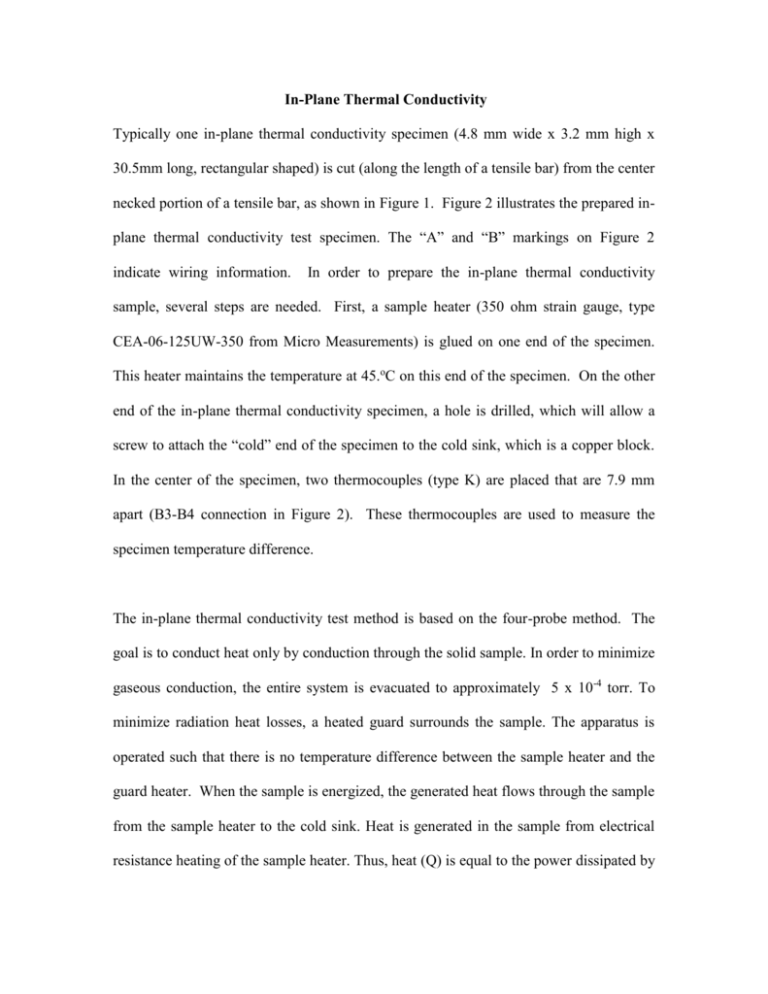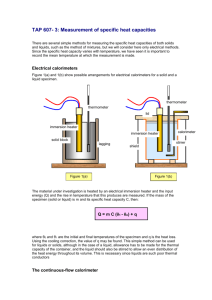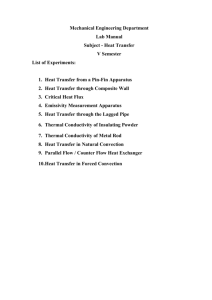In-Plane Thermal Conductivity Test Equipment
advertisement

In-Plane Thermal Conductivity Typically one in-plane thermal conductivity specimen (4.8 mm wide x 3.2 mm high x 30.5mm long, rectangular shaped) is cut (along the length of a tensile bar) from the center necked portion of a tensile bar, as shown in Figure 1. Figure 2 illustrates the prepared inplane thermal conductivity test specimen. The “A” and “B” markings on Figure 2 indicate wiring information. In order to prepare the in-plane thermal conductivity sample, several steps are needed. First, a sample heater (350 ohm strain gauge, type CEA-06-125UW-350 from Micro Measurements) is glued on one end of the specimen. This heater maintains the temperature at 45.oC on this end of the specimen. On the other end of the in-plane thermal conductivity specimen, a hole is drilled, which will allow a screw to attach the “cold” end of the specimen to the cold sink, which is a copper block. In the center of the specimen, two thermocouples (type K) are placed that are 7.9 mm apart (B3-B4 connection in Figure 2). These thermocouples are used to measure the specimen temperature difference. The in-plane thermal conductivity test method is based on the four-probe method. The goal is to conduct heat only by conduction through the solid sample. In order to minimize gaseous conduction, the entire system is evacuated to approximately 5 x 10-4 torr. To minimize radiation heat losses, a heated guard surrounds the sample. The apparatus is operated such that there is no temperature difference between the sample heater and the guard heater. When the sample is energized, the generated heat flows through the sample from the sample heater to the cold sink. Heat is generated in the sample from electrical resistance heating of the sample heater. Thus, heat (Q) is equal to the power dissipated by the resistor (V x I). Figure 3 illustrates this test method. Using Fourier’s law, the thermal conductivity of the specimen is determined by the following equation. K (V )( I ) d ( ) T A 1 where : K = thermal conductivity of the specimen being tested V = voltage drop across the sample heater resistor I = current through the sample heater resistor T = temperature difference across the specimen being tested, Ta-Tb in Figure 3 d = distance between the two junctions of the thermocouples (typically 7.9 mm) A = cross sectional area of the specimen (specimen width x specimen height) Typically for each specimen, it takes 2 hours to prepare a sample and 2 hours to conduct the testing. Flow & Measurement Figure 1: Portion of Tensile Bar from which In-Plane Thermal Conductivity Test Specimen is Cut B8 B7 B3 A3 A4 A1 A2 SAMPLE GUARD HEATER B1 B4 SAMPLE HEATER B2 Figure 2: In Plane Thermal Conductivity Wiring Diagram HEAT SINK Fourier’s Law of Heat Conduction Q/A = K (ΔT/d) l Q A Q a b w Ta d Figure 3: In Plane Thermal Conductivity Test Method Tb h Photograph of In Plane Thermal Conductivity Equipment Another Explanation Of This Same Test Method The figure below shows a schematic of this test method, and the numbers in parentheses in this section refer to numbers in this figure. The goal is to conduct heat only by conduction through the solid sample. In order to minimize heat loss due to convection, the entire system was evacuated to less than 10-3 torr. To minimize radiation heat losses, a heated guard surrounds the sample (#5). The apparatus is operated such that no temperature difference (TGuard) was present between the sample heater (#3) and the guard heater (#4). When the sample heater (#3) is energized, the generated heat flowed through the sample from the sample heater to the heat sink (#1). The heat sink creates a temperature gradient allowing the heat to flow down the sample, since the heat sink is at a lower temperature than the sample. The heat sink is typically kept at 45C. The sample is attached to the heat sink by a screw (#2) and heat sink compound (Dow Corning 340 Fluid). Heat is generated in the sample from the electrical resistance heating of the sample heater (#3). Thus, heat created is equal to the power dissipated by the resistor (V x I). The only remaining variable that needs to be obtained is the temperature difference between the two thermocouples (T1 and T2). This is accomplished simply by measuring the voltage difference between the thermocouples. Once the system is at steady state, the following values are measured: 1. Voltage across the sample heater (V) 2. Current through the sample heater (I) 3. Voltage across the two sample thermocouples (v) 4. Current through the guard heater 5. System pressure The values measured are used to calculate the longitudinal thermal conductivity along with the same samples’ width (w) and height (h) as well as the distance between the sample thermocouples (d) is calculated by the equation below. T1 V T2 I 3 T guard 6 4 2 5 1 Diagram of In-Plane Thermal Conductivity Apparatus K 1600.9 V I d w hv Reference Weber, E. H., "Development and Modeling of Thermally Conductive Polymer/Carbon Composites", Ph.D. dissertation in Chemical Engineering, Michigan Technological University, December 2001.






